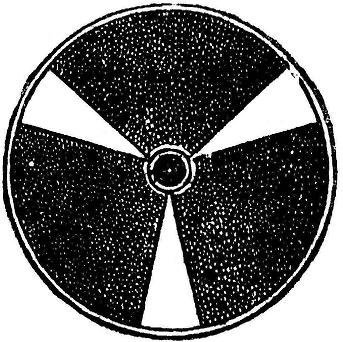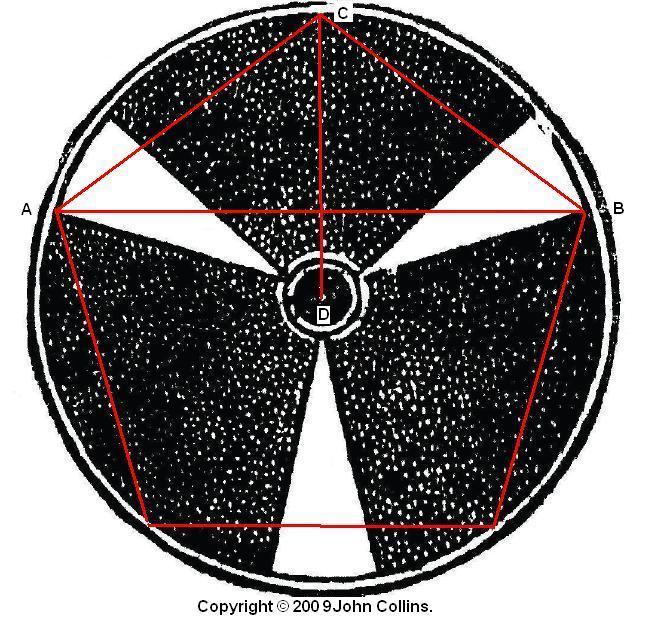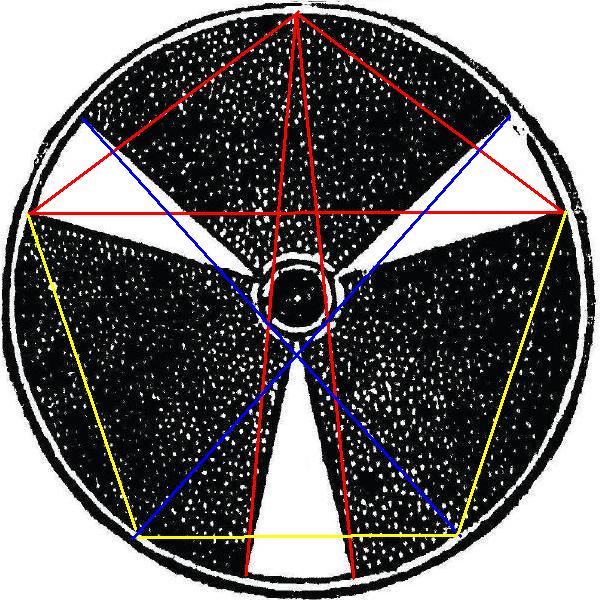|
This book was Bessler’s first major published work and is clearly all his own. I cannot be certain but I am of the opinion that he might have done all his own typesetting, always assuming that he could borrow the equipment. There is a multitude of pieces of coded information, buried in this publication, but the Apologia wheel drawing at the end of this book interested me initially because it looked so simple and because of the intriguing and mysterious hint in the accompanying text. This is discussed on the ‘Chronogram’ page. I measured the angles at the inner end of the white segments and discovered, as others have found, that the angles are ambiguous – a bit too vague to measure accurately. I noticed that the angles in the white segment formed a point outside the inner circles and that the black segments did not in fact form any measurable angle unless you extended them to a point which came somewhere beyond the centre of the wheel. Due to the way things were printed in those times the exact sizes of the angles were difficult to establish. I felt that there must be another reason for the inclusion of this diagram with its cryptic comment above, and Bessler must have made allowances for the irregularities of the printing techniques of his time. If he knew that the angles would be hard to measure then perhaps the exact measurement did not matter? I measured the white angles again and established that they were variously somewhere between 23 degrees and 27 degrees. I added together each set of the same three numbers forming each of the three angles to see if the sum of the three numbers had any meaning. Using the angles as measured between 23 and 27 degrees, I ended up with several possible totals between 69 and 81. I divided the resultant totals into the 360 degrees of a circle and there was just one number which divided equally into 360 and that was the first real advance in deciphering Bessler’s code. During my research I have discovered that Bessler rarely, if ever, missed an opportunity to include two clues or ways of deciphering a clue, within each item that held a clue and the above Apologia wheel is no exception. For those who remain unconvinced that the above diagram does indeed hold a hidden pentagram the following will go some way towards convincing them of this fact.
The above drawing is virtually self-explanatory. Draw a line from ’A’ to ’B’ as in the drawing. Drop a perpendicular through the centre of the wheel from ‘C’ to ‘D’. The length of the chord from ‘A’ to ‘C’ is equal to one chord of a pentagram. Simply fill in the remaining four chords to complete the pentagram. Examples of this system of double clues abounds in Bessler’s work and is a way of confirming what initial findings appear to indicate. Added 27th April 2010 There is still the possibility of an additional clue hidden in the curiously drawn axle in the centre of the Apologia wheel. It consists of a white dot denoting the centre, surrounded by a solid black circle. Surrounding this in turn is a white circle which is itself surrounded by a black circle and finally another white circle but one divided by three terminations of the three white segments. Just decoration? No. In the next figure notice the same red lines as in the drawing above.First I drew the red horizontal line (as AB above). Next I drew in the two almost vertical red lines, which begin at the lowest corners of the bottom white segment and rise, deliberately skimming the edge of the solid black circle. Note that they meet at the upper edge of the circumference, indicating the same point as ‘C’ does in the above figure. This allows you to draw in the two upper arms of the pentagon
The edge of the solid black circle provides the two datum points for the nearly vertical red lines which define the top of the perpendicular line through the centre. The not-solid black circle provides the two datum points for the blue lines the lower ends of which define the remaining pentagon points This not only explains the reason for the elaborate centre circles but also proves the presence of the pentagon. QED I believe that this demonstrates Bessler’s system of encoding. He uses simple ways of hiding information; his methods require nothing more than a ruler and possibly a compass and a pencil For more information about Johann Bessler and to obtain copies of his books with English translations go to www.free-energy.co.uk Copyright © 2009 John Collins.
|
| NavB[Home] [Bessler's name code] [Apologia Pentagram] [AP chronogram] [AP blanks & dashes] [AP Chapter 55] [Bessler's Initials] [Portrait pentagram] [More 1st portrait] [2nd portrait] [Pentagram in GB] [Golden Mean] [MT 55 pentagram] [MT Nos & letters] [MT 137 part one] [MT 137 part two] [MT 137 part three] [Bessler's Logo] [Drawing no codes] [5th DT Drawing] [Water wheel]wing |


